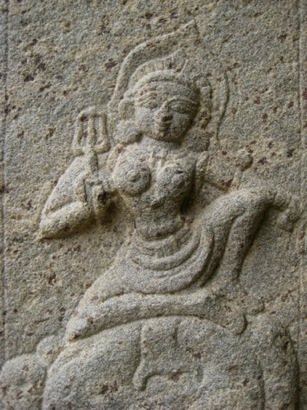Where Did Yoga Originate?
What is Yoga?
Yoga refers to traditional physical and mental disciplines originating in India. The history of Yoga spans from four to eight thousand years ago to the current day. The physical, mental and spiritual health benefits of yoga are vast and there is something for everyone.

Where Did Yoga Originate?
"The aim of all yoga practice is to achieve truth wherein the individual or soul identifies itself with the supreme soul or God."
Swami Vishnu Devananda
History of Yoga - A Complete Overview of the Yoga History
Here is an excellent article summing up the answer to 'where did yoga originate...
Written by: shaynebance from the ABC of Yoga web site
The saying, "What's in the past, should stay in the past" doesn't work here.
We might already have an idea of what Yoga is but to understand it better, we have to know what it has become as well as its roots and beginnings. A quick look at the history of Yoga will help us appreciate its rich tradition and who knows, it might help us incorporate Yoga into our lives.
Although Yoga is said to be as old as civilization, there is no physical evidence to support this claim. Earliest archaeological evidence of Yoga's existence could be found in stone seals which depict figures of Yoga Poses. The stone seals place Yoga's existence around 3000 B.C.
Scholars, however, have a reason to believe that Yoga existed long before that and traced its beginnings in Stone Age Shamanism. Both Shamanism and Yoga have similar characteristics particularly in their efforts to improve the human condition at that time. Also, they aim to heal community members and the practitioners act as religious mediators. Though we know Yoga as focusing more on the self, it started out as community-oriented before it turned inward.
For a better discussion of the history of Yoga, we could divide it into four periods: the Vedic Period, Pre-Classical Period, Classical Period, and Post-Classical Period.
Vedic Period
The existence of the Vedas marks this period. The Vedas is the sacred scripture of Brahmanism that is the basis of modern-day Hinduism. It is a collection of hymns which praise a divine power. The Vedas contains the oldest known Yogic teachings and as such, teachings found in the Vedas are called Vedic Yoga. This is characterized by rituals and ceremonies that strive to surpass the limitations of the mind.
During this time, the Vedic people relied on rishis or dedicated Vedic Yogis to teach them how to live in divine harmony. Rishis were also gifted with the ability to see the ultimate reality through their intensive spiritual practice. It was also during this time that Yogis living in seclusion (in forests) were recorded.
Pre-Classical Yoga
The creation of the Upanishads marks the Pre-Classical Yoga. The 200 scriptures of the Upanishads (the conclusion of the revealed literature) describe the inner vision of reality resulting from devotion to Brahman. These explain three subjects: the ultimate reality (Brahman), the transcendental self (atman), and the relationship between the two. The Upanishads further explain the teachings of the Vedas.
Yoga shares some characteristics not only with Hinduism but also with Buddhism that we can trace in its history. During the sixth century B.C., Buddha started teaching Buddhism, which stresses the importance of Meditation and the practice of physical postures. Siddharta Gautama, the first Buddhist to study Yoga, achieved enlightenment at the age of 35.
Later, around 500B.C., the Bhagavad-Gita or Lord's Song was created and this is currently the oldest known Yoga scripture. It is devoted entirely to Yoga and has confirmed that it has been an old practice for some time. However, it doesn't point to a specific time wherein Yoga could have started. The central point to the Gita is that - to be alive means to be active and in order to avoid difficulties in our lives and in others, our actions have to benign and have to exceed our egos.
Just as the Upanishads further the Vedas, the Gita builds on and incorporates the doctrines found in the Upanishads. In the Gita, three facets must be brought together in our lifestyle: Bhakti or loving devotion, Jnana which is knowledge or contemplation, and Karma which is about selfless actions. The Gita then tried to unify Bhakti Yoga, Jnana Yoga, and Karma Yoga and it is because of this that it has gained importance. The Gita was a conversation between Prince Arjuna and God-man Krishna and it basically stresses the importance of opposing evil.
Classical Period
The Classical Period is marked by another creation - the Yoga Sutra. Written by Patanjali around the second century, it was an attempt to define and standardize Classical Yoga. It is composed of 195 aphorisms or sutras (from the Sanskrit word which means thread) that expound upon the Raja Yoga and its underlying principle, Patanjali's Eightfold path of Yoga (also called Eight Limbs of Classical Yoga). These are:
1. Yama, which means social restraints or ethical values;
2. Niyama, which is personal observance of purity, tolerance, and study;
3. Asanas or physical exercises;
4. Pranayama, which means breath control or regulation;
5. Pratyahara or sense withdrawal in preparation for Meditation;
6. Dharana, which is about concentration;
7. Dhyana, which means Meditation; and
8. Samadhi, which means ecstasy.
Patanjali believed that each individual is a composite of matter (prakriti) and spirit (purusha). He further believed that the two must be separated in order to cleanse the spirit - a stark contrast to Vedic and Pre-Classical Yoga that signify the union of body and spirit.
Patanjali's concept was dominant for some centuries that some Yogis focused exclusively on Meditation and neglected their Asanas. It was only later that the belief of the body as a temple was rekindled and attention to the importance of the Asana was revived. This time, Yogis attempted to use Yoga techniques to change the body and make it immortal.
Post-Classical Yoga
At this point, we see a proliferation of literature as well as the practice of Yoga. Post-classical Yoga differs from the first three since its focus is more on the present. It no longer strives to liberate a person from reality but rather teaches one to accept it and live at the moment.
Yoga was introduced in the West during the early 19th century. It was first studied as part of Eastern Philosophy and began as a movement for health and vegetarianism around the 1930's. By the 1960's, there was an influx of Indian teachers who expounded on Yoga. One of them was Maharishi Mahesh, the Yogi who popularized Transcendental Meditation. Another one is a prominent Yoga Guru Swami Sivananda. Sivananda was a doctor in Malaysia and he later opened schools in America and Europe. The most prominent of his works is his modified Five Principles of Yoga which are:
1. Savasana or proper relaxation;
2. Asanas or proper exercise;
3. Pranayama or proper breathing;
4. Proper diet; and
5. Dhyana or positive thinking and Meditation
Sivananda wrote more than 200 books on Yoga and Philosophy and had many disciples who furthered Yoga. Some of them were Swami Satchitananda who introduced chanting and Yoga to Woodstock; Swami Sivananada Radha who explored the connection between psychology and Yoga, and Yogi Bhajan who started teaching Kundalini Yoga in the 70's.
Up to this day, Yoga continues to proliferate and spread its teachings, crossing the boundaries of culture and language.

Best Yoga DVDs |
Hand Yoga |
Hand Yoga Videos
Do you have a Yoga Question?
Return from where did yoga originate to Tibetan yoga
Return from where did yoga originate to homepage